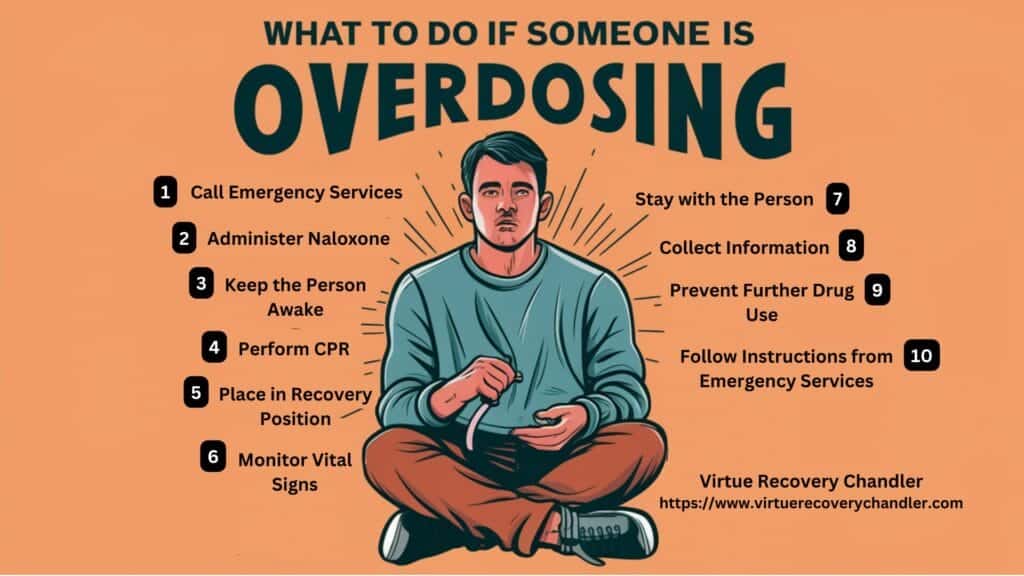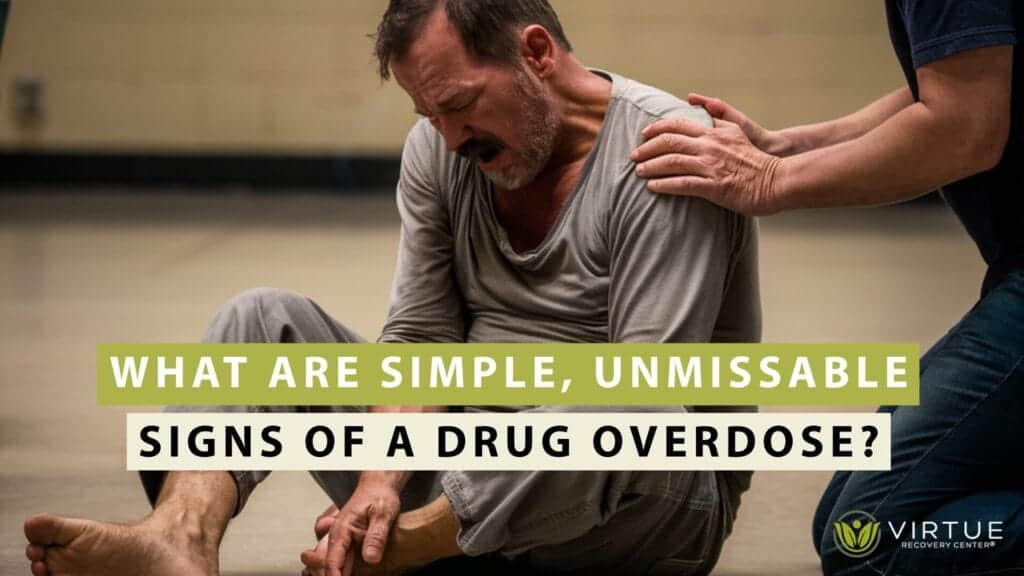KEY TAKEAWAYS
- Rising Overdoses: Overdoses are increasingly common, particularly with opioids like fentanyl.
- Varied Effects: Overdose effects differ based on the substance, dosage, and individual body chemistry.
- Severe Consequences: Overdoses can be life-threatening and have severe consequences.
- Critical Recognition: Recognizing overdose signs is essential for quick, life-saving responses.
- Swift Action Needed: Immediate and informed action during an overdose can be life-saving.
- Prevention Efforts: Overdose prevention requires both individual and community efforts to mitigate substance use risks.
Recognizing the symptoms of a drug overdose can be a lifesaver. Overdoses are now very common and tragic, so it is important to know the easy-to-spot signs that show someone may be overdosing. Knowing this allows people to act fast and, thus, save their lives. Whether dealing with prescription drugs, over-the-counter medicines, alcohol, or illicit substances, understanding these critical symptoms is essential for anyone who wants to be prepared to respond in an emergency.
What Is An Overdose?
An overdose occurs when a person takes too much of a substance, overwhelming the body’s ability to cope with the drug’s effects. The body’s organs and systems can be seriously affected, which in turn may result in the death of a person. Overdoses are particularly linked to opioids like heroin or prescription painkillers like fentanyl and oxycodone, but stimulants, depressants, and other substances can also cause them.
The severity and symptoms of an overdose are determined by many different factors, such as the kind and quantity of the substance used and also by the individual’s body chemistry. Some symptoms of an overdose are very heavy sleep, confusion, hard breathing, and finally, the loss of consciousness. In the case of opioids, symptoms can also be pinpointed pupils and slowed heart rate. These signs are indicators of a life-threatening condition; therefore, one should immediately go to the hospital for help. Overdoses are a medical emergency, and timely treatment can significantly affect outcomes.
What are the factors that can contribute to an overdose?
Various factors can contribute to an overdose, creating complex interactions of risks that differ from person to person. One of the primary factors is the dosage and strength of the substance. Large amounts of strong drugs, like fentanyl, greatly increase the chance of overdose. Moreover, the interaction of various substances like opioids with alcohol or benzodiazepines can increase their effects. It can amplify their impact and lead to dangerous interactions that strengthen the risk of overdose.
Individual factors are also a very important determinant of the probability of an overdose. A person’s tolerance to a substance, which is not constant and changes with time, determines how their body reacts to the drug. For example, people who have stopped using a substance and then started again at the same dose as before are more likely to experience an overdose. Underlying health conditions can also be a factor in making an overdose more severe. Psychological factors, such as mental health disorders and stress, can also exacerbate the effects of an overdose. Understanding these factors is essential for prevention efforts and providing targeted education and intervention.
How Can I Recognize Signs of an Overdose?
Recognizing the symptoms of an overdose is very important for a timely intervention and can be life-saving. Physical signs differ from substance to substance but are usually similar and include heavy drowsiness, confusion, and unresponsiveness. Physical signs like slow or irregular breathing, a slow or erratic pulse, and pale or clammy skin are also indicators. Particular substances can cause specific symptoms; for instance, opioid overdoses usually result in pinpoint pupils, while stimulant overdoses may lead to hyperactivity, agitation, and chest pain. If you see any of these signs, getting medical help as soon as possible is necessary because quick action can greatly increase the chances of survival and recovery.
Common Symptoms for Recognizing Someone Is Overdosing
- Extreme Drowsiness or Unresponsiveness: Difficulty staying awake or inability to wake up.
- Slow or Erratic Pulse: Irregular heartbeat or significantly slow heart rate.
- Confusion or Disorientation: Lack of awareness of surroundings, inability to respond appropriately.
- Slow or Irregular Breathing: Shallow, labored, or significantly reduced breathing rate.
- Pinpoint Pupils: Very small, constricted pupils, especially common in opioid overdoses.
- Pale or Clammy Skin: Cold, sweaty, and pale appearance.
- Loss of Consciousness: Total lack of response to stimuli, indicating a severe overdose.
- Nausea or Vomiting: Uncontrolled vomiting, leading to aspiration.
- Seizures or Convulsions: Involuntary twitching or shaking.
- Bluish Skin, Lips, or Fingertips: Cyanosis, indicating lack of oxygen.
- Chest Pain: Tightness or pain in the chest, often associated with stimulant overdoses.
- Agitation or Anxiety: Hyperactivity or extreme nervousness, common with stimulant overdoses.
- Disassociation from reality: Intense experiencing of hallucinations, detachment from reality.
- Increased blood pressure and/or heart rate: This can lead to cardiovascular complications.
Recognizing these signs quickly can help you take immediate action, such as calling emergency services and providing life-saving first aid.
Recognizing an Overdose
The identification of overdose symptoms allows people to respond quickly and act accordingly, saving lives. Overdoses can manifest through a variety of symptoms, which vary depending on the substance involved. Below is a detailed view of the general signs of an overdose, followed by the drug-specific symptoms.
Breathing Changes: Breathing patterns are one of the most important signs to be aware of. It can range from the slow, shallow breathing usually seen with opioid overdoses to the rapid breathing that comes with stimulant use. In the worst cases, breathing may completely cease. These differences demonstrate the body’s incapability to deal with the toxic levels of substances that are ingested.
Consciousness Changes: Overdoses usually cause changes in consciousness. This can be seen as a person being unresponsive, where he/she cannot wake up or respond to stimuli, or as confusion and disorientation, which makes it difficult for him/her to understand or interact with his/her environment.
Physical Signs: Look for signs like pale, clammy skin, which means the body struggles with normal functions. Blue or purple fingernails and lips are signs of oxygen deprivation, which is a serious and immediate problem. Other symptoms are vomiting, as the body tries to get rid of the toxic substance; gurgling sounds that may indicate airway obstruction; and changes in pupil size—pinpoint or significantly dilated, depending on the drug.
Changes in Behavioral: Behavioral changes can range widely from agitation and seizures, which are usually associated with stimulant overdoses, to the unusual calmness or stupor that is often seen with depressant abuse. The loss of coordination and difficulty in moving are also typical, signaling the drug’s impact on the brain’s motor control centers.
Immediate Actions: What To Do If You Suspect An Overdose
If you suspect someone is overdosing, immediate action is critical. First, call emergency services right away to get professional medical help on the way. While waiting for responders, try to keep the person awake and breathing. If they are unconscious but breathing, place them in the recovery position on their side to prevent choking. If the person is not breathing, perform CPR if you are trained to do so. Administer naloxone (Narcan) if available and if you suspect an opioid overdose, as it can temporarily reverse the effects. Stay with the person, monitoring their condition and providing reassurance until emergency personnel arrive. Prompt and informed actions can make the difference between life and death in overdose situations.
If you think someone is overdosing, the first thing to do is act immediately. Begin by calling emergency services immediately to get professional medical assistance on its way. During the time when you are waiting for responders, keep the person awake and breathing. If they are unconscious but breathing, put them in the recovery position on their side to avoid choking. If the person is not breathing, start CPR immediately. Administer naloxone (Narcan) if it is available and if you think the person is having an opioid overdose, as it can reverse the effects of an overdose. Stay with the person, watch their condition, and reassure them until someone comes. Quick and well-informed decisions can be the line between life and death in overdose cases.
- Call Emergency Services: Dial emergency services immediately to get professional medical help.
- Administer Naloxone (if applicable): Use naloxone (Narcan) if you suspect an opioid overdose and have it available.
- Keep the Person Awake and Breathing: Encourage the person to stay awake and take deep breaths.
- Perform CPR (if necessary): If the person is not breathing or has no pulse, perform CPR if trained.
- Place in Recovery Position: If unconscious but breathing, lay the person on their side to prevent choking.
- Monitor Vital Signs: Continuously check their breathing, pulse, and responsiveness.
- Stay with the Person: Do not leave the individual alone; provide reassurance and comfort.
- Collect Information: Gather any information about the substances taken to inform medical personnel.
- Prevent Further Drug Use: Remove any remaining drugs or paraphernalia from the person’s reach.
- Follow Instructions from Emergency Services: Adhere to any advice or instructions from emergency operators until help arrives.

If someone overdoses, it is very important to avoid actions that could make their condition worse. Do not leave the person alone, as their condition could worsen quickly without someone to watch them. Do not let them eat or drink anything, which could lead to choking. Never try to make a person vomit, as this can cause aspiration and other problems. Never put the person in a cold shower or bath, as this could result in shock. Do not give any substances or drugs unless it is naloxone for an opioid overdose, as other substances could have bad interactions. Lastly, do not wait to call emergency services, as time is of the essence in overdose cases.
DON’T:
- Delay Calling 911
- Wait to administer Naloxone
- Accuse or berate the person
- Leave the person
Preventing Overdoses
Overdose prevention should be a comprehensive approach involving both individual and community efforts to reduce the risks of substance use. Fundamental to this is practicing safe medication habits: the safekeeping of medications, the strict adherence to the prescribed dosages and also the correct disposal of unused or expired drugs so as not to misuse them. Additionally, harm reduction strategies are very important. They include providing naloxone and creating a supportive environment where people can get help without stigmatizing. The joint activities of these two groups are the key to decreasing the risk of an overdose.
Finding Help and Support
For those struggling with substance abuse, getting help and support is an important step in recovery. Many resources exist, such as local community support groups and professional treatment facilities that provide customized recovery programs. National helplines and medical websites also offer confidential advice that can lead people and their loved ones to the right services. The use of these resources can be a way to cure and, at the same time, avoid the terrible results of overdoses.
Virtue Recovery: Helping Find the Path to Sobriety
Within the spectrum of recovery institutions, Virtue Recovery stands out with its unwavering commitment to guiding individuals toward a victorious fight against addiction.
Treatment centers like Virtue Recovery merge evidence-based practices with compassion, nurturing not just the body but the soul. If today finds you in the shadows of addiction, take solace in knowing that support systems exist, waiting to walk this journey with you.
Enrolling in a reputable recovery program is your stepping stone to reclaiming the healthy, addiction-free life you deserve. Click here to begin your journey to recovery.
FAQ: What Are Simple, Unmissable Signs of a Drug Overdose
Q: What is an overdose?
A: An overdose is when someone takes a toxic amount of a drug, overwhelming the body’s ability to cope with its effects. This can result in severe, potentially fatal consequences.
Q: What substances can cause an overdose?
A: Overdoses can be caused by prescription medications, over-the-counter drugs, alcohol, and illicit substances. Common drugs include opioids, benzodiazepines, barbiturates, alcohol, and stimulants.
Q: What are common signs of a drug overdose?
A: Common signs include extreme drowsiness, confusion, slow or irregular breathing, slow or erratic pulse, pinpoint pupils, bluish skin, lips, or fingertips, pale or clammy skin, nausea or vomiting, seizures, chest pain, severe agitation, and loss of consciousness.
Q: What immediate actions should I take if I suspect someone is overdosing?
A: Call emergency services immediately, administer naloxone if available and if appropriate, keep the person awake and breathing, perform CPR if necessary, place them in the recovery position if unconscious but breathing, monitor their vital signs, and stay with them until help arrives.
Q: What should I avoid doing if someone is overdosing?
A: Do not leave the person alone, give them anything to eat or drink, try to induce vomiting, put them in a cold shower or bath, administer substances other than naloxone, or delay calling emergency services.
Q: What are some factors contributing to an overdose?
A: Contributing factors include the dosage and potency of the substance, mixing different substances, individual tolerance levels, underlying health conditions, and psychological factors such as stress and mental health disorders.
Q: How can I prevent an overdose?
A: Practice safe medication habits by securely storing medications, following prescribed dosages, and properly disposing of unused medications. Employ harm reduction strategies like providing access to naloxone and creating supportive environments for seeking help without stigma.
Citations
Los Angeles County Department of Public Health. Nov. 2023. Data Report. Fentanyl Overdoses in Los Angeles County.
Drug Overdose Treatment – WebMD. https://www.webmd.com/first-aid/drug-overdose-treatment
What happens during an opioid overdose – CDC.gov. https://www.cdc.gov/rx-awareness/prevent/?CDC_AAref_Val=https://www.cdc.gov/rxawareness/prevent/index.html
Signs & symptoms of overdose – learn2cope.org. https://learn2cope.org/signs-symptoms-of-overdose/
Drug overdose – betterhealth.vic.gov.https://www.betterhealth.vic.gov.au/health/healthyliving/drug-overdose









